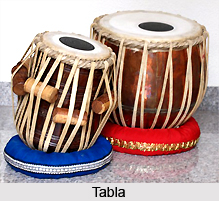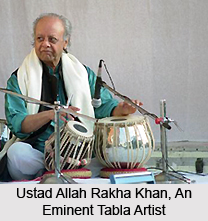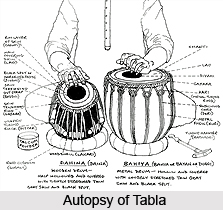 Tabla is one of the primary percussion instruments in North India since the eighteenth century. The Tabla actually comprises two separate drumheads, one played by each hand. However, it is considered as one drum with two heads. The name Tabla usually refers to the right drum. More precisely, it is called `dahina or `dayan,` meaning right. `Bayan,` which means `left,` indicates the left drum. The two drums are totally unalike, but complement each other beautifully. In quality the sound of the Tabla is slightly lighter than that of the Mridanga and the Pakhavaj and hence the instrument is used in various forms of light music and Khayal singing.
Tabla is one of the primary percussion instruments in North India since the eighteenth century. The Tabla actually comprises two separate drumheads, one played by each hand. However, it is considered as one drum with two heads. The name Tabla usually refers to the right drum. More precisely, it is called `dahina or `dayan,` meaning right. `Bayan,` which means `left,` indicates the left drum. The two drums are totally unalike, but complement each other beautifully. In quality the sound of the Tabla is slightly lighter than that of the Mridanga and the Pakhavaj and hence the instrument is used in various forms of light music and Khayal singing.
History of Tabla
Many theories have been proffered regarding the history of the Tabla. While some believe that it had its origins in the Pakhavaj, some others hold that the Tabla, like the sitar and other instruments, was introduced into Indian Classical Music by Amir Khusrau in the 13th century. This theory assumes that the Tabla came from the far west. The term Tabla can be traced back to the Arabic term `tabl`. It is a generic term meaning drum. The first iconographic depiction of an instrument that closely resembles the present-day Indian Tabla was found in 1808. For a period of approximately fifty years before this date, however, a veritable flood of Mughal-style miniatures show pairs of instruments which attest to the presence of two types of hand-played drum pairs in contiguous areas of northwestern India: the Punjab (wooden cylindrical pairs) and the Delhi-Rajasthan-Oudh area (metal or clay hemispherical pairs). It appears that sometime during the middle or latter half of the 18th century these two drum types were combined: for the right hand, the fixed-pitch cylindrical Punjabi "Tabla" was chosen; for the left hand, the variable-pitch hemispherical Delhi "Duggi."
 This instrument is believed to have undergone a number of alterations between 1750 and 1850. The Tabla used today is probably no more than seventy to one hundred years old.
This instrument is believed to have undergone a number of alterations between 1750 and 1850. The Tabla used today is probably no more than seventy to one hundred years old.
Structure of Tabla
The dahina (right drum) is the higher and more precisely pitched of the pair. Its shape is wider at the bottom and tapering upward. Its widest point is about five to six and a half centimeters above its base. It is made of oak or rosewood. The bayan is tuned to a general pitch area approximately an octave lower. Nowadays, bayan are made of German silver, a silver-white alloy formed of copper, zinc, and nickel. The sizes of Tabla and bayan vary greatly, partly to suit the player`s aesthetic taste, partly to fit the size of his hand, and partly according to the instrument they are likely to be used with, whether for accompanying or other purposes. The Tabla and bayan heads are both of the composite type, with the top layer of skin cut to a narrow band around the outer edge. Both heads are of goatskin. A circle of black tuning paste applied to the surface of the second layer controls the vibrations of the head. This circle, which is applied in the centre of the Tabla, is close to an edge on the bayan, presumably to allow room for the use of the wrist and heel of the left hand. On both drums the paste is permanent; to change it, one must replace the head.
A small goat-hide hoop is placed at the bottom of each drum. A larger, interlaced goat-hide hoop holds the skin in position on the top of each drum, and goat-hide lacing lashed between the two hoops holds the skin tense. Small cylinder-shaped blocks of wood are wedged between the lacing and the body of the drum on the dahina. Once the blocks are in place, one may adjust the tension of the head by hammering them up or down.
 Playing of Tabla
Playing of Tabla
The sounds produced on the Tabla and bayan are either open or closed (damped or undamped). There is a repertoire of strokes for each hand separately and for the hands together. The index, third, and fourth fingers of the right hand are used, and one stroke calls for the hand to be almost flattened and the fingers to be straight and rocked sideways on the head. On the bayan, the index and middle fingers of the left hand are used, as well as the heel of the hand (for pressure). A range of pitch can be produced on the bayan either by exerting pressure with the heel of the hand or by sliding the hand lightly across the head toward the paste. Exploitation of the range by a drummer is greatly admired. Drummers usually keep a supply of powder nearby to sprinkle on the drumheads. The powder makes it easier to move the fingers and hands quickly.




